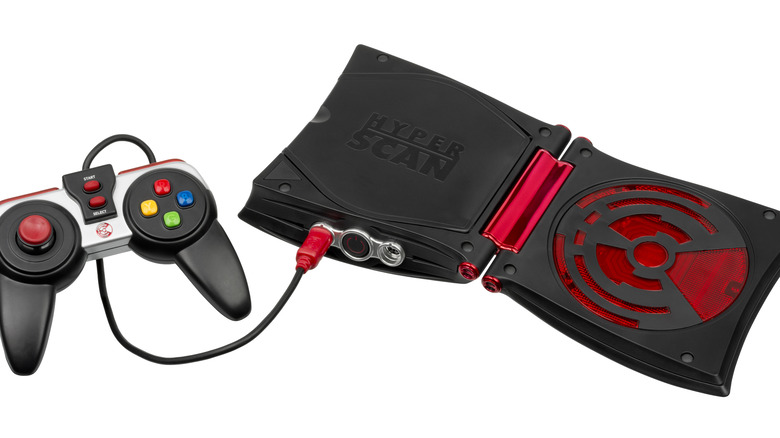Why The Mattel HyperScan Was A Complete Failure
Most of today's gamers only know the big three video game companies—Nintendo, Microsoft, and Sony. Therefore, some gamers might be surprised to learn that, over the years, many other companies have attempted to break into the gaming market with their own consoles. While most of these endeavors failed, a few examples stand out from the pack as having been especially catastrophic. The Mattel HyperScan, for example, ended in absolute disaster.
Released by the toy company Mattel in 2006, at first, the HyperScan seemed promising. A few unique features—most notably its ability to scan trading cards using RFID technology—helped the HyperScan stand out from the pack, according to PC World. However, only one year after its release, virtually no one was buying the console, forcing Mattel to discontinue its production. So, what exactly went wrong? When it comes to a device as riddled with issues as the HyperScan, it's hard to pin its failure on only one feature.
What went wrong
As mentioned above, at first, the HyperScan appeared to be a revolutionary device. According to PC World, the device's RFID technology should have made it a "marketer's dream." With every game sold for the console, a booster pack of trading cards was also sold, each card containing an RFID chip that could be read by the machine. According to TV Tropes, The cards could perform several in-game functions, like powering up characters and loading in save data.
In theory, according to PC World, Mattel could have continued to make and sell cards, creating an "infinite tail" on the sale of games. There was just one problem: the RFID reader on the device didn't work. When the key feature of your gaming console is "flaky," that's never a good sign. Imagine if the Nintendo Wii's motion controllers were "flaky." It's no wonder the HyperScan failed to catch steam.
This was far from the HyperScan's only major bug. According to TV Tropes, the CPU and GPU were low-quality compared to competitors, the CD-ROM drive was slow, and the games were poorly programmed. Furthermore, when it comes to aesthetics, the system wasn't exactly easy on the eyes.
The Hyperscan's failure wasn't for nothing
In an industry as hardcore and cutthroat as video gaming, it's easy to pile on the failures of an underperforming console. What's more difficult but perhaps more needed is gratitude. Because, like it or not, success is often bred by the failures of past generations. This sentiment is even true within the confines of the video game industry. In order to bring about significant change, sometimes it takes a failure like the Mattel HyperScan.
While the system may have been less-than-stellar, it pioneered Near Field Communication (NFC) and RFID gaming, according to TV Tropes. So, if it wasn't for the Mattel HyperScan, other NFC titles such as "Disney Infinity" and "Skylanders" may never have been released. If you or anyone close to you has ever gotten any enjoyment out of such titles, perhaps a little thanks are in order for the console that made it all possible.



